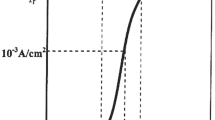Abstract
This paper describes design of a structured composite varistor (voltage variable resistor) exhibiting a positive voltage coefficient of resistance. This structured composite consists of a thick film resistor printed on a lead magnesium niobate-lead titanate substrate. In this device the variation of resistance due to an applied voltage is produced through the coupling of piezo electric strain to a thick film resistor. It has been found that this resistor can give rise to a positive voltage coefficient of resistance when used as a three terminal or four terminal device. A mathematical model is developed to establish the variation of resistance with an applied voltage. Dimensional dependence of voltage coefficient of resistance (α v ) was investigated by varying the width of the thick film resistor while keeping its length constant. It was found that α v is inversely proportional to the width of the thick film resistor.




Similar content being viewed by others
References
D.R. Clarke, Varistor ceramics. J. Am. Ceram. Soc. 82(3), 485–502 (1999)
K.L. Kishore, K. Ramkumar, M. Satyam, Varistors based on barium titanate-graphite-rubber composites. J. Appl. Phys. 61(1), 397–403 (1987)
K.L. Kishore, K. Ramkumar, M. Satyam, Variable resistors based on composites. J. Phys. D Appl. Phys. 20, 386–389 (1987)
S.E. Park, T.R. Shrout, Ultrahigh strain and piezoelectric behavior in relaxor based ferroelectric single crystals. J. Appl. Phys. 82(4), 1804–1811 (1997)
Z.W. Yin, H.S. Luo, P.C. Wang, G.S. Xu, Growth, characterization and properties of relaxor ferroelectric PMNPT single crystals. Ferroelectrics 229(1), 207–216 (1999)
B. Jaffe, W.R. Cook, H. Jaffe, Piezoelectric ceramics, (Academic Press, London, 1971)
L.V. Azaroff, J.J. Brophy, Electronic processes in materials, (McGraw-Hill Book. Co, New York, 1963)
Acknowledgments
Authors would like to thank National Centre for Compositional Characterisation of Materials (CCCM) Hyderabad and Raja Ramanna Centre for Advanced Technology (RRCAT), Indore for their support in this work.
Author information
Authors and Affiliations
Corresponding author
Appendix
Appendix
For PMNPT, the Piezoelectric stain coefficient d 31 is negative and d 33 is positive. As mentioned earlier, for the converse piezoelectric effect in which an applied field E produces proportional strain s, the value of d coefficient is numerically the same as that, in the case of direct effect [6].
The strain produced in the PMNPT disc is coupled to the rubber-graphite thick film through Poisson’s ratio p.
Due to change in the thickness of the film, there is change in current flow, between the conducting granules, Assuming the current flow to be due to field emission, as given by Fowler–Nordheim equation, the current I that flows when a voltage V 2 is applied between the two terminals of the thick film, may be written as,
E′ is the electric field present between two graphite particles, due to voltage V 2
Electric field across the thin rubber film between two conducting particles, E′ is given by
Resistance of one gap between the conducting particles, R g , is given by
Number of contacts in series along the length of the film = L/(D + t 0)
Resistance due to such parallel contacts = (R g L)/w
Substituting Eqs. (10, 11) in Eq. (15), Eq. (16) can be obtained, which describes the relation between the variation of thick film resistance with respect to the voltage applied to the PMNPT disc, as given below:
Rights and permissions
About this article
Cite this article
Narasimham, K.V.N.S.V.P.L., Kishore, K.L. Dimensional Dependence of Voltage Coefficient of Resistance (αv) for PMNPT Based Varistors. J. Inst. Eng. India Ser. B 96, 349–353 (2015). https://doi.org/10.1007/s40031-014-0110-3
Received:
Accepted:
Published:
Issue Date:
DOI: https://doi.org/10.1007/s40031-014-0110-3



